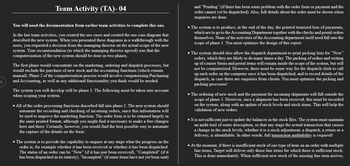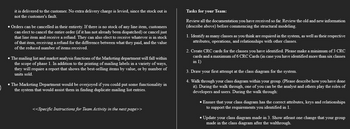Question
use lucidchart to create graphs thanks

Transcribed Image Text:Team Activity (TA)- 04
You will need the documentation from earlier team activities to complete this one.
In the last team activities, you created the use cases and created the use-case diagram that
described the new system. When you presented these diagrams in a walkthrough with the
users, you requested a decision from the managing director on the actual scope of the new
system. Your recommendation (to which the managing director agreed) was that the
computerization of the new system should be done in two phases.
The first phase would concentrate on the marketing, ordering and dispatch processes, but
would exclude the purchase of new stock and the accounting functions (which remain
manual). Phase 2 of the computerization process would involve computerizing Purchasing
and Accounting, as well as any additional functionality you think would be needed.
The system you will develop will be phase 1. The following must be taken into account
when scoping your system.
• All of the order processing functions described fall into phase 1. The new system should
automate the recording and checking of incoming orders, since this information will
be used to improve the marketing function. The order form is to be retained largely in
the same printed format, although you might find it necessary to make a few changes
here and there. Certainly, however, you would find the best possible way to automate
the capture of the details on the form.
• The system is to provide the capability to enquire at any stage what the progress on the
order is, for example whether it has been received or whether it has been dispatched.
The status of an order can be "New" (if it has just been received), "Completed" (if it
has been dispatched in its entirety). “Incomplete” (if some items have not yet been sent)
and "Pending" (if there has been some problem with the order form or payment and the
order cannot yet be dispatched). Also, full details about the order must be shown when
enquiries are done.
• The system is to produce, at the end of the day, the printed itemized lists of payments,
which are to go to the Accounting Department together with the checks and postal orders
themselves. None of the activities of the Accounting department itself need fall into the
scope of phase 1. You must optimize the design of this report.
The system should also allow the dispatch department to print picking lists for "New"
orders, which they are likely to do many times a day. The packing of orders and writing
up of courier forms and postal items will remain inside the scope of the system, but will
not be computerized. However, there must be some way for the dispatch clerk to call
up each order on the computer once it has been dispatched, and to record details of the
dispatch, in case there are enquiries from clients. You must optimize the picking and
packing processes!
• The ordering of new stock and the payment for incoming shipments will fall outside the
scope of phase 1. However, once a shipment has been received, this must be recorded
on the system, along with an update of stock levels and stock items. This will help the
validation of new orders.
It is not sufficient just to update the balances in the stock files. The system must maintain
an audit trail of some description, so that any stage the actual transaction that causes
a change in the stock levels, whether it is a stock adjustment, a dispatch, a return or a
delivery, is identifiable. In other words, full transaction auditability is required!
At the moment, if there is insufficient stock of one type of item on an order with multiple
line items, Target will deliver only those line items for which there is sufficient stock.
This is done immediately. When sufficient new stock of the missing line item arrives,

Transcribed Image Text:it is delivered to the customer. No extra delivery charge is levied, since the stock out is
not the customer's fault.
• Orders can be cancelled in their entirety. If there is no stock of any line item, customers
can elect to cancel the entire order (if it has not already been dispatched) or cancel just
that line item and receive a refund. They can also elect to receive whatever is in stock
of that item, receiving a refund for the difference between what they paid, and the value
of the reduced number of items received.
The mailing list and market analysis functions of the Marketing department will fall within
the scope of phase 1. In addition to the printing of mailing labels in a variety of ways,
they will require a report that shows the best-selling items by value, or by number of
units sold.
• The Marketing Department would be overjoyed if you could put some functionality in
the system that would assist them in finding duplicate mailing list entries.
<<<Specific Instructions for Team Activity in the next page>>
Tasks for your Team:
Review all the documentation you have received so far. Review the old and new information
(describe above) before commencing the structural modeling.
1. Identify as many classes as you think are required in the system, as well as their respective
attributes, operations, and relationships with other classes.
2. Create CRC cards for the classes you have identified. Please make a minimum of 3 CRC
cards and a maximum of 6 CRC Cards (in case you have identified more than six classes
in 1)
3. Draw your first attempt at the class diagram for the system.
4. Walk through your class diagram within your group. (Please describe how you have done
it). During the walk through, one of you can be the analyst and others play the roles of
developers and users. During the walk through:
• Ensure that your class diagram has the correct attributes, keys and relationships
to support the requirements you identified in 1.
• Update your class diagram made in 3. Show atleast one change that your group
made in the class diagram after the walthrough.
Expert Solution
This question has been solved!
Explore an expertly crafted, step-by-step solution for a thorough understanding of key concepts.
Step by stepSolved in 2 steps with 2 images
